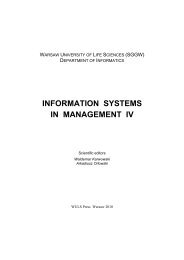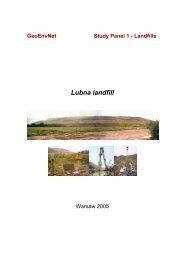36 S. Kalinowskiin 786 and 559 households. The research was carried out in all the 31 districts of Wielkopolskievoivodship. The inquiry questionnaire consisted of 88 questions divided into 11thematic blocks. The selected questions from the III, V, X and XI block (households incomes,responder’s and household’s economic activity, education and subjective poverty)were used by the elaboration of the paper. The unpublished data of the Main StatisticalOffice from 2005 concerning the socio-material situation of rural population had a supplementarycharacter.The contemporary market economy, setting economic aims as priorities, results inincreased competition for foreign investments among communes. The potential investorsdecide about new locations basing on the possibility of using the synergy effect. Themain area of competition are rural areas, which constitute 95% of the area of the Wielkopolskievoivodship and are inhabited by nearly 45% of its overall population. Therefore,they constitute a considerable reservoir of human resources. New challenges of knowledge-basedeconomy impose an improvement in the quality of the capital. Raising thelevel of education becomes a necessity and, at the same time, increases the chances ofdevelopment of households and is conducive to an improvement in the situation in thelabour market and, consequently, participating in social welfare. As a result, investmentsin human capital become inevitable in the process of household development and in thedevelopment of the society as a whole.EDUCATION AND THE COMPETITIVENESS OF THE RURAL POPULATIONIN WIELKOPOLSKADefining human capital is the key element of the considerations on building the competitivenessof households, particularly in rural areas. Its peculiarity derives from the factthat it cannot be materialised as assets acquired on the market, but through self-investments[Marciniak 2002]. Most generally, it can be treated as a total of interrelated variablessuch as knowledge, skills, experience, creative thinking and the capability of workas well as mobility aimed at finding better employment, health and psychical welfare.These features, though they are not the only determinants, significantly determine theresources of this capital.The value and the meaning of human capital, also more broadly understood as socialcapital, result from the fact that it constitutes one of the three dimensions of sustainabledevelopment. The participation of the inhabitants of rural areas, i.e. active participation ofcitizens in managing social issues, is the key factor in the process of expansion [Juroszek2008, Hauser 1999]. However, in order to be able to talk about unlimited subjectivity ofthe rural population, it is necessary to meet a number of conditions, including the mostimportant one – constant improvement in the quality of human resources, including theimprovement in their education. Therefore, education is treated as investment and one ofthe elements raising the marginal productivity of human capital. The data from the NationalGeneral Census shows that the rural population is worse educated than the urbanone. The educational gap with regard to university graduates amounts to 9.2 percentagepoints (there was an increase of 1.9 percentage points between censuses). Although thelevel of education of the rural population has been on the increase for a long time, overActa Sci. Pol.
Education as an element of competitiveness of rural households in the Wielkopolskie... 37three quarters of the rural population have no secondary education. While people withsecondary and post-comprehensive education constitute the greatest percentage of theurban population, most of the population living in the country have primary educationor even lower (Figure 1). This situation results from, among others, greater educationalobstacles encountered by the rural environment. A number of families cannot afford tosend children to secondary schools, universities or colleges in bigger towns.The improvement in education in recent years has been caused, among others, by theextinction of the oldest generation, i.e. the worst educated one at the same time and bya lower urban migration balance. It legitimises the claim that the migration of educatedpeople has been limited, but on the other hand, the better educated and those able to findtheir place on the labour market decide to stay in urban areas, which offer both greateropportunities of getting a satisfactory job and a wider range of future choices. Accordingto Orczyk [2005], the four most important challenges in the coming years include maintainingeducational aspirations in society, eliminating significant differences in access toeducation, developing various forms of educating adults and instant improvement in educationquality. Rural youth realise the necessity of further education and making continualimprovements to one’s skills. The research conducted in 2007 shows that only only onein ten households (9.6%) includes people over 18 not continuing their education on secondarylevel, which constitutes a decrease by nearly two percentage points. Respondentsclaim the main reason for discontinuing education to be financial problems (41.3%), andlearning difficulties (28.6%). It is also problematic that 27% still believe that the educationthey have achieved is sufficient and there is no need for them to continue their education(Figure 2). According to a number of opinions, an excess of university graduates canresult in a discouragement from one’s own self-development, however, the market hasnot been saturated yet in rural areas and the distance, in comparison with urban citizens,is still quite considerable [Kalinowski, Łuczka-Bakuła 2007].academic education – wykształcenie wyższepost-comprehensive and secondary education –wykształcenie policealne i średnievocational education – wykształcenie zasadniczezawodoweprimary education – wykształcenie podstawowe4,213,421,338,124,934,021,837,4no education – bez wykształcenia3,01,9wieś – ruralmiasto – urban0 5 10 15 20 25 30 35 40 45Fig. 1. Education levels among the inhabitants of the Wielkopolskie Voivodship in 2002Rys. 1. Struktura wykształcenia mieszkańców województwa wielkopolskiego 2002 rokuSource: Author’s own calculation based on Gospodarstwa domowe i rodziny. Województwo wielkopolskie,Poznań 2003.Źródło: Opracowanie własne na podstawie Gospodarstwa domowe i rodziny. Województwo wielkopolskie,Poznań 2003.Oeconomia 10 (1) 2011
- Page 6 and 7: 6 A. Gawrońska, S. Paszkowskicultu
- Page 8 and 9: 8 A. Gawrońska, S. Paszkowskinumbe
- Page 10 and 11: 10 A. Gawrońska, S. PaszkowskiTabl
- Page 12: 12 A. Gawrońska, S. PaszkowskiTabl
- Page 15 and 16: The distribution of social security
- Page 17 and 18: %180,0160,0140,0120,0100,080,060,04
- Page 19: The distribution of social security
- Page 22 and 23: 22 R. Hryniewski, W. Mądry, D. Goz
- Page 24 and 25: 24 R. Hryniewski, W. Mądry, D. Goz
- Page 26 and 27: 26 R. Hryniewski, W. Mądry, D. Goz
- Page 28 and 29: 28 R. Hryniewski, W. Mądry, D. Goz
- Page 30 and 31: 30 R. Hryniewski, W. Mądry, D. Goz
- Page 32 and 33: 32 R. Hryniewski, W. Mądry, D. Goz
- Page 35: Oeconomia 10 (1) 2011, 35-43EDUCATI
- Page 39 and 40: Education as an element of competit
- Page 41 and 42: Education as an element of competit
- Page 43: Education as an element of competit
- Page 46 and 47: 46 E. Majewski, P. Sulewski, M. Rag
- Page 48 and 49: 48 E. Majewski, P. Sulewski, M. Rag
- Page 50 and 51: 50 E. Majewski, P. Sulewski, M. Rag
- Page 52 and 53: 52 E. Majewski, P. Sulewski, M. Rag
- Page 54 and 55: 54 E. Majewski, P. Sulewski, M. Rag
- Page 56 and 57: 56 E. Majewski, P. Sulewski, M. Rag
- Page 58 and 59: 58 L. Mazal, K.J. RowlesIn the West
- Page 60 and 61: 60 L. Mazal, K.J. RowlesThe most im
- Page 62 and 63: 62 L. Mazal, K.J. RowlesGDPt= GDP0+
- Page 64 and 65: 64 L. Mazal, K.J. RowlesTHE TIME SE
- Page 66 and 67: 66 L. Mazal, K.J. RowlesTable 4. Ac
- Page 68 and 69: 68 L. Mazal, K.J. RowlesNelson Ch.R
- Page 70 and 71: 70 A. Ptak-Chmielewskastatistics, w
- Page 72 and 73: 72 A. Ptak-Chmielewska3025birth rat
- Page 74 and 75: 74 A. Ptak-ChmielewskaSECTOR OF ACT
- Page 76 and 77: 76 A. Ptak-Chmielewskabirth rate fo
- Page 78 and 79: 78 A. Ptak-Chmielewskawere trade fi
- Page 80 and 81: 80 A. Ptak-ChmielewskaREFERENCESBal
- Page 83 and 84: Oeconomia 10 (1) 2011, 83-95THE EFF
- Page 85 and 86: The effi ciency of selected real es
- Page 87 and 88:
The effi ciency of selected real es
- Page 89 and 90:
Table 1. Efficiency of real estate
- Page 91 and 92:
The effi ciency of selected real es
- Page 93 and 94:
The effi ciency of selected real es
- Page 95:
The effi ciency of selected real es
- Page 98 and 99:
98 J. Sosnowski, G.A. CiepielaJalin
- Page 100 and 101:
100 J. Sosnowski, G.A. Ciepiela2007
- Page 102 and 103:
102 J. Sosnowski, G.A. CiepielaTabl
- Page 104 and 105:
104 J. Sosnowski, G.A. CiepielaTabl
- Page 106 and 107:
106 J. Sosnowski, G.A. Ciepiela1400
- Page 108 and 109:
108 J. Sosnowski, G.A. CiepielaOsek
- Page 110 and 111:
110 E. SzymańskaProducts by Activi
- Page 112 and 113:
112 E. Szymańskatroduced TFI which
- Page 114 and 115:
114 E. Szymańskabers of companies
- Page 116 and 117:
116 E. SzymańskaTable 3. Tourism v
- Page 118 and 119:
118 E. SzymańskaREFERENCESCoccossi
- Page 120 and 121:
120 J. WiśniewskaEvery society can
- Page 122 and 123:
122 J. WiśniewskaStatistical analy
- Page 124 and 125:
124 J. WiśniewskaCommon Agricultur
- Page 126 and 127:
126 J. WiśniewskaTable 3. An attem
- Page 128 and 129:
128 J. Wiśniewskathe application o
- Page 130 and 131:
130 J. Wiśniewskainstitutional cos
- Page 132 and 133:
132 J. Wiśniewskaemployed in agric
- Page 134 and 135:
134 J. WiśniewskaLong term viabili
- Page 136 and 137:
136 J. Wiśniewska--The level of re
- Page 139 and 140:
Oeconomia 10 (1) 2011, 139-148INNOV
- Page 141 and 142:
Innovativeness of food production e
- Page 143 and 144:
Innovativeness of food production e
- Page 145 and 146:
Innovativeness of food production e
- Page 147 and 148:
Innovativeness of food production e
- Page 149 and 150:
Oeconomia 10 (1) 2011, 149-158LOCAL
- Page 151 and 152:
Local governance activities in supp
- Page 153 and 154:
Local governance activities in supp
- Page 155 and 156:
Local governance activities in supp
- Page 157 and 158:
Local governance activities in supp
- Page 159 and 160:
Oeconomia 10 (1) 2011, 159-169CHANG
- Page 161 and 162:
Changes in rural women’s movement
- Page 163 and 164:
Changes in rural women’s movement
- Page 165 and 166:
Changes in rural women’s movement
- Page 167 and 168:
Changes in rural women’s movement
- Page 169:
Changes in rural women’s movement
- Page 172:
Ewa SzymańskaTourism function of M
















